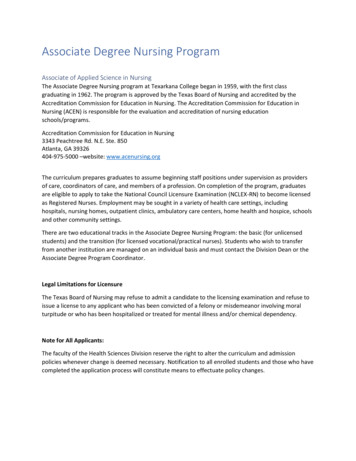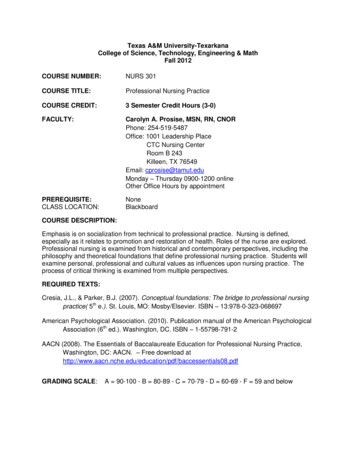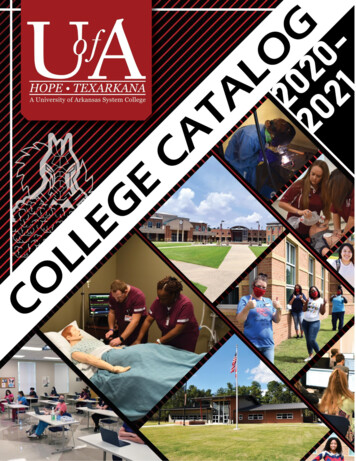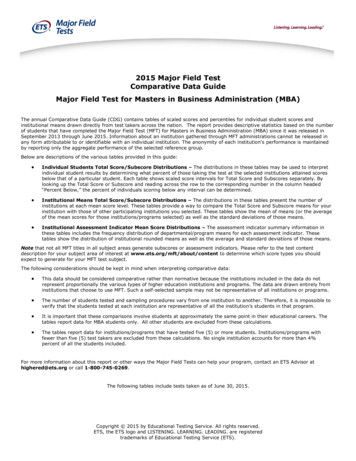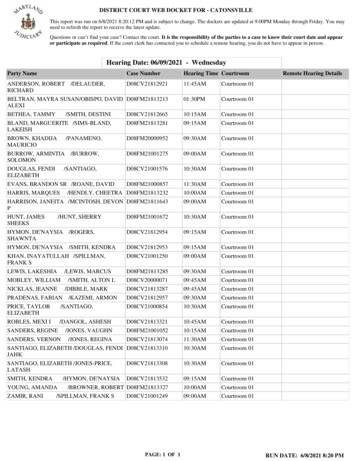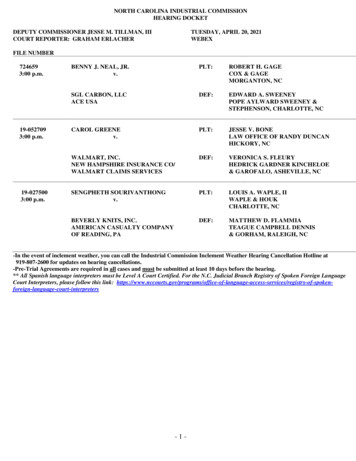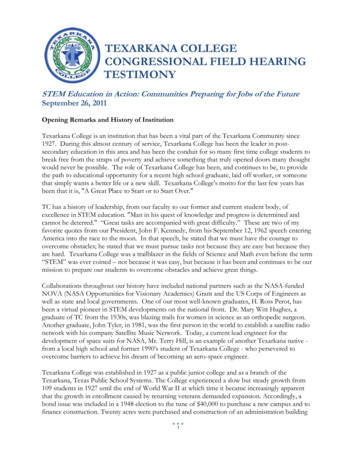
Transcription
TEXARKANA COLLEGECONGRESSIONAL FIELD HEARINGTESTIMONYSTEM Education in Action: Communities Preparing for Jobs of the FutureSeptember 26, 2011Opening Remarks and History of InstitutionTexarkana College is an institution that has been a vital part of the Texarkana Community since1927. During this almost century of service, Texarkana College has been the leader in postsecondary education in this area and has been the conduit for so many first time college students tobreak free from the straps of poverty and achieve something that truly opened doors many thoughtwould never be possible. The role of Texarkana College has been, and continues to be, to providethe path to educational opportunity for a recent high school graduate, laid off worker, or someonethat simply wants a better life or a new skill. Texarkana College's motto for the last few years hasbeen that it is, "A Great Place to Start or to Start Over."TC has a history of leadership, from our faculty to our former and current student body, ofexcellence in STEM education. "Man in his quest of knowledge and progress is determined andcannot be deterred." “Great tasks are accompanied with great difficulty.” These are two of myfavorite quotes from our President, John F. Kennedy, from his September 12, 1962 speech enteringAmerica into the race to the moon. In that speech, he stated that we must have the courage toovercome obstacles; he stated that we must pursue tasks not because they are easy but because theyare hard. Texarkana College was a trailblazer in the fields of Science and Math even before the term“STEM” was ever coined – not because it was easy, but because it has been and continues to be ourmission to prepare our students to overcome obstacles and achieve great things.Collaborations throughout our history have included national partners such as the NASA-fundedNOVA (NASA Opportunities for Visionary Academics) Grant and the US Corps of Engineers aswell as state and local governments. One of our most well-known graduates, H. Ross Perot, hasbeen a virtual pioneer in STEM developments on the national front. Dr. Mary Witt Hughes, agraduate of TC from the 1930s, was blazing trails for women in science as an orthopedic surgeon.Another graduate, John Tyler, in 1981, was the first person in the world to establish a satellite radionetwork with his company Satellite Music Network. Today, a current lead engineer for thedevelopment of space suits for NASA, Mr. Terry Hill, is an example of another Texarkana native from a local high school and former 1990’s student of Texarkana College - who persevered toovercome barriers to achieve his dream of becoming an aero-space engineer.Texarkana College was established in 1927 as a public junior college and as a branch of theTexarkana, Texas Public School Systems. The College experienced a slow but steady growth from109 students in 1927 until the end of World War II at which time it became increasingly apparentthat the growth in enrollment caused by returning veterans demanded expansion. Accordingly, abond issue was included in a 1948 election to the tune of 40,000 to purchase a new campus and tofinance construction. Twenty acres were purchased and construction of an administration building1
and gymnasium began in 1950. In October of 1951 the college relocated to its present site onRobison Road with an enrollment of 589 students.Today, Texarkana College (TC) enrolls more than 10,000 individuals annually. The TC MissionStatement reads: Texarkana College prepares individuals for success in life by providing qualityopportunities for workforce education and academic advancement. TC is a comprehensivecommunity college located in the border city of Texarkana, TX and offers Associate and AppliedAssociate Degrees, Distance Education, Dual Credit, Workforce Education, Certificates, andContinuing Education courses. Since 1971, Texarkana College has collaborated with other postsecondary higher education institutions to provide seamless transfer of credit for students. TexasA&M University-Texarkana (TAMU-T) is our community partner and affords students with accessto bachelor and graduate degree programs. TC’s service areas consist of all of Bowie County, a largeportion of Cass County and a small portion of Red River County in Texas. In addition, we are aborder county with Miller County in Arkansas and serve these residents as well. TC is an openadmission institution located in the twin cities of Texarkana, Texas/Arkansas serving a uniquegeographic area where four states (Texas, Arkansas, Louisiana, and Oklahoma) meet.Our student profile is twenty-eight percent economically disadvantaged with seventy-five percent(75%) Caucasian, and twenty-five percent (25%) minorities. Sixty-one percent (61%) of students areyounger than twenty-five and sixty-five percent (65%) are female. In FY 2010, 751 degrees andcertificates were awarded. Of which 28.8% were awarded to minorities. Approximately sixtypercent (60%) were part time enrollees with 40% enrolled full time; approximately 70 % of ourstudent population is enrolled in academic programs while 30% are in workforce educationprograms. Almost 83 % of our total academic students are employed after graduation and/or go onto pursue a four-year degree. Graduates of our workforce education programs have a slightly higherrate with almost 85% employed and/or enrolled.Texarkana College has made a commitment in the last two years to establishing a culture of evidencefor the entire campus by becoming an Achieving the Dream institution. As we move forward,knowledge gained and information and data shared through this nationwide network of communitycolleges will be a driving factor in insuring that Texarkana College remains focused on fulfilling itsmission: To prepare individuals for success in life by providing quality opportunities for workforce educationand academic advancement. In May, 2011, Texarkana College was selected as one of the top 120community colleges in the nation from over 1000 community colleges nationwide to compete inRound 2 of The Aspen Prize for Community College Excellence which seeks to accelerate efforts toimprove community college student outcomes and shine a spotlight on community colleges thatdeliver exceptional student results through the development of high-quality measures andbenchmarks for assessing student outcomes. Texarkana College is very proud to have beenrecognized and included in the Achieving the Dream and Aspen Prize community of institutionsnationwide seeking to bring about transformation in community college student success.Section I:Role of TC in the US economyTexarkana College has a solid working relationship with Workforce Solutions Northeast Texas, theregional office of the Texas Workforce Commission. Realizing that one of Texarkana College’sgreatest contributions to our regional economy is preparing a skilled workforce for our employers,the institution strives to promote the attainment of certificates in technical fields that lead to2
employment in the local market. TC has proven that historically we have had great success in theaward of certificates in technical fields that lead to jobs. TC students from the 2004-2005 graduatingcohort receiving a certificate earn an average wage of 32,635. For students who graduated with anAssociate’s Degree from Texarkana College in 2004-2005, their 2010 Annualized earnings are 38,613.The college takes an active role in collecting data on labor market training demands by participatingand hosting regional planning summits with professionals from the fields of healthcare, advancedmanufacturing and technology. The nine-county area served by Workforce Solutions NortheastTexas has a broad and diverse manufacturing base. One of the primary employers in this arena is theRed River Army Depot (RRAD). RRAD is located 18 miles west of Texarkana. The Depot, whichwas established in1941, repairs, and converts combat/tactical wheeled vehicles and operates the U.S.Department of Defense’s only road wheel and track-shoe rebuild manufacturing facility. Manycontractors support the work at RRAD including Day & Zimmerman, URS Corporation, Raytheon,M2 Services, BAE, and L-3 Corp. Adjacent to RRAD is the TexAmericas Center. In 1998, the RedRiver Redevelopment Authority was chartered as a Special Purpose District by the Texas Legislatureto transform former military land and buildings into a privately held industrial park. This industrialpark is now known as the TexAmericas Center. RRAD and its affiliated tenants at the TexAmericasCenter currently employs 5,458 people, including Federal civilian employees (3,403), tenantactivities/workers (1,004), active duty military (3), workers employed by contractors (784) and 264others not elsewhere classified.TC recently established a19,000 sq. ft. training center at the TexAmericas Center development park.With support from a recent Texas Military Preparedness grant funded through the Texas Governor'sOffice, this training center specializes in training dislocated and new workers in heavy equipmentoperation, mechanics, welding, machinery and related skills. Training at this site began in Summer,2011. The skills being taught at this facility were identified in direct response to employers’ requestand include: robotics and process automation; instrumentation technology; Programmable LogicController; advanced welding/pulse welding; electromechanical, instrumentation and maintenancetechnologies (multi-craft), solid modeling and design, and integrated systems technology as well asdiesel engine and transmission diagnostics and repair. These courses lead to certificates in thespecified field and meet regional labor demand.Texarkana USA serves as the medical technology and health care industry hub for the Ark-La-Texregion. In the 1950s, Texarkana College began the first Associate Degree Nursing program forcommunity colleges in the State of Texas and was later the first community college in the nation toreceive National League for Nursing accreditation. TC is a leading producer of highly trainednursing and EMT/Paramedic workforce personnel in the region. The TC Nursing Program has anabove-average passing rate of 96% of students taking the Texas Board of Nursing licensure examfor Associate Degree Nursing (RN) and a 93% passing rate for Vocational Nursing students.3
Section II:TC Collaborative PartnersPARTNER ENTITYKEY CONTACT NAME/TITLE AND EMAILDESCRIPTION OFPARTNERSHIPAtlanta High School (TX)Avery High School (TX)Bloomburg H.S. (TX)DeKalb High School (TX)Fouke High School (AR)Hooks High School (TX)James Bowie H.S.(TX)Liberty-Eylau H.S. (TX)Linden-Kildare H. S. (TX)Maud High School (TX)McLeod High School (TX)New Boston H.S. (TX)Pleasant Grove H.S. (TX)Queen City H.S. (TX)Redwater H.S. (TX)Texas High School (TX)Arkansas High School (AR)Counselor: Audrea Allen aallen@atlist.netCounselor: Brent Jackson brent.jackson@averyisd.netCounselor: Monique Irwin mirwin@bloomburgisd.netCounselor: Lea Dooley lea.dooley@dekalbisd.netCounselor: Mike Mack mmack@fouke.swsc.k12.ar.usCounselor: Chris Fountain fountain@hooksisd.netCounselor: Dru Driver ddriver@simmsisd.netCounselor: Pat Hearn pat.hearn@leisd.netCounselor: Stacey Alexander salexander@lkcisd.netCounselor: Paula Lewis plewis@maud.esc8.netCounselor: Nyla Dowd ndowd@mcleodisd.netCounselor: Paula Turner pturner@nbschools.netCounselor: LouAnne Smith lsmith@pgisd.netCounselor: Jana Scharnberg jscharnberg@qcisd.netCounselor: Hollie Collatt hcollat@redwaterisd.orgCounselor: Stephanie Casteel stephanie.casteel@txkisd.netCounselor: Amanda McJunckins amanda.mcjunckins@tasd7.netThese are the K-12institutions that serve as theprimary partnershipsTexas WorkforceCommission/ WorkforceSolutions NE TexasKay O’Dell, kay.odell@twc.state.tx.usExecutive DirectorRed River Army DepotLt. Col. Doyle Lassitter, Commandercharles.lassitter@us.army.milChristus St. Michael HealthSystemsChris Karam, Christus St. Michael CEOchris.karam@christushealth.orgWadley Regional HealthSystemTom Gilbert, Wadley Health Systems CEOtgilbert@wadleyhealth.comReunion Nursing HomeFederal CorrectionsInstitution (FCI)Michael Carvahal; Warden; mcarvahal@bop.govWorkforce SolutionsNortheast Texas providesreferrals to our programsand provides trainingvouchers to eligiblestudents.Training partner andoutreach to over 5,000civilian Depot employeesRegional hospitals partnerwith Texarkana Collegeand provide preceptors foron-site nurse training. Inaddition, hospital CEOsserve on the College’sstrategic planning council.Texarkana Collegeinstructors teach on-site atthe Federal CorrectionalInstitution to providecertificates in technicalfields.Reverse Transfer of CreditTexas A&M UniversityTexarkanaPatricia Comstock, Director of Educational Programs;pcomstock@bop.govTex- Rep CommunityTheatre (Non Profit)Dr. C.B. Rathburn, PresidentTexas A&M University- TexarkanaCarlisle.rathburn@tamut.eduVicki Al-Dubais, PresidentVickie.Al-Dubais@txkisd.netRegion 8 Education ServiceCenterDr. Ray Glynn, Executive Directorrglynn@reg8.net4Enrich and supportTexarkana College TheatreDepartmentPre-service teacherpreparation
Section III:Barriers to STEM Success/TC Involvement in K-12 STEM EducationTo keep a finger on the pulse of the vitally important healthcare industry, Texarkana College hasrecently participated in two sequential studies to identify variables that have led to a nurse andhealthcare shortage in Northeast Texas. It was determined that students are not graduating at a ratesufficient to keep pace with the demand for a skilled workforce. Texarkana College has taken stepsto identify students most at-risk and help nursing and health occupation students remain in collegeand overcome barriers that keep them from persisting. Criteria for identification of at-risk studentsfocused on the following variables: reading comprehension, math scores, Anatomy & Physiologygrades, family support, and working more than sixteen hours a week.Texarkana College has implemented a system to identify “at-risk” in-coming nursing students byasking them to complete a survey to determine methods of intervention to assist them withpersistence and completion. Intervention methods include counseling that addressing stress, anxiety,time management, family support, critical thinking, test-taking skills, and lecture class participationstrategies. Programs also conducted an intensive one-on-one test remediation for students whofailed their first test in the Fundamentals of Nursing course by using the Missildine ExamDiagnostic Tool.In addition, through our partnership with Texas A&M University-Texarkana, nursing students haveaccess to expanded counseling services to assist with academic, personal, and financial counseling.As a result of the aggressive outreach measures in place through the Health Occupations departmentat Texarkana College, the Nursing Program has an above-average passing rate of 96% of studentstaking the Texas Board of Nursing licensure exam for Associate Degree Nursing (RN) and a 93%passing rate for Vocational Nursing students.As an Achieving the Dream institution, Texarkana College has made the transition to data drivendecision making. Programs across the TC campus are using data to evaluate their services orprograms and outcomes. Our data showed that one of the areas that hinder student success is thedevelopmental math sequence. In response, the TC math faculty has created three innovativecurriculum concepts based on current best practices to prevent students from losing their mathmomentum - Modular Math, Integrated Intermediate and College Algebra, and Math Boot Camp.All of these curriculum changes are designed to move students through the sequence more quicklyinto college credit bearing coursework and toward completion of a degree, certificate or transferstatus. One part of the math initiative involves the widespread implementation of collaborativelearning techniques and technology. The math initiative will impact all students enrolling indevelopmental mathematics courses and college level mathematic courses which equates toapproximately 2000 or more students annually.All three mathematics interventions are designed to improve successful completion rates in thedevelopmental math program. Students placing into the developmental math series are less likelythan their counterparts to successfully complete a college credit mathematics course or even topersist in college enrollment due to the length of time it may take to complete the developmentalmath coursework. The data show achievement gaps tied to the following subgroups: ethnicity(African American), Pell, gender (male), age (18-19). However, this intervention targets theacademically underprepared student population (based upon their placement into the developmental5
math sequence) in its entirety. As a result, the needs of these subgroups will be represented whenthey fall within the targeted population.The Mathematics Department and Institutional Research office will assess the effectiveness of thesechanges through persistence and successful course completion rates for all developmental mathcourses, College Algebra, and the sequence collectively, disaggregated by standard characteristics,and compare it with baseline data with ongoing treated versus non-treated sections of each course.Also, success rates for Student Learning Outcomes established for each course will be compared intreated versus non-treated sections. In addition, course enrollment rates throughout theimplementation process will be tracked for comparison of treated versus non-treated sections.Surveys will be administered each semester in each course to both students and faculty to evaluatethe level of satisfaction and engagement in the treated versus non-treated sections. Each semesterthese data will be shared with key stakeholders to improve the decision making process andultimately improve and transform student success in mathematics at TC.Texarkana College contributes to K-12 STEM education in many diverse ways. Three primarycontributions are in pre-service teacher preparation, in-service teacher professional development,and sponsorships of student led activities for TC students to collaborate with public schoolsstudents and for public school students to compete in cutting edge national events.TC STEM faculty members are leaders both locally and across the state in pre-service teacherpreparation and in-service teacher professional development programs. Key mathematics facultymembers from TC have in the past eighteen years served on advisory boards at the state level inestablishing guidelines for the mathematical preparation of pre-service elementary, middle and highschool teachers and in developing guidelines to improve the STEM preparation of public highschool students for college and career readiness.These math faculty members have received ongoing professional development as statewide trainersfor Texas Education Agency approved initiatives in mathematics professional development andincorporated current best practices into the mathematics curriculum at TC, as well as providedprofessional development in both content development and appropriate pedagogy to in-serviceteachers across Northeast Texas – actually across the state.One of our senior math faculty members has twice been selected as a master mathematics trainer forthe State of Texas, has collaborated with public school mathematics teachers at all K-12 levels andpartnered with the Region 8 Education Service Center to deliver training in best practices inmathematics and science education through the grant funded Texas Regional Collaborative forScience, Mathematics and Technology Excellence. Through this same faculty member, TC hasprovided grant funded professional development opportunities to area educators in math andscience on the application of graphing technology and calculator based laboratories and other handheld data collection devices. This math faculty member also compiled an
Texarkana College was established in 1927 as a public junior college and as a branch of the Texarkana, Texas Public School Systems. The College experienced a slow but steady growth from 109 students in 1927 until the end of W

